Topic
Papers and Code
MTOS: A LLM-Driven Multi-topic Opinion Simulation Framework for Exploring Echo Chamber Dynamics
Oct 14, 2025The polarization of opinions, information segregation, and cognitive biases on social media have attracted significant academic attention. In real-world networks, information often spans multiple interrelated topics, posing challenges for opinion evolution and highlighting the need for frameworks that simulate interactions among topics. Existing studies based on large language models (LLMs) focus largely on single topics, limiting the capture of cognitive transfer in multi-topic, cross-domain contexts. Traditional numerical models, meanwhile, simplify complex linguistic attitudes into discrete values, lacking interpretability, behavioral consistency, and the ability to integrate multiple topics. To address these issues, we propose Multi-topic Opinion Simulation (MTOS), a social simulation framework integrating multi-topic contexts with LLMs. MTOS leverages LLMs alongside short-term and long-term memory, incorporates multiple user-selection interaction mechanisms and dynamic topic-selection strategies, and employs a belief decay mechanism to enable perspective updates across topics. We conduct extensive experiments on MTOS, varying topic numbers, correlation types, and performing ablation studies to assess features such as group polarization and local consistency. Results show that multi-topic settings significantly alter polarization trends: positively correlated topics amplify echo chambers, negatively correlated topics inhibit them, and irrelevant topics also mitigate echo chamber effects through resource competition. Compared with numerical models, LLM-based agents realistically simulate dynamic opinion changes, reproduce linguistic features of news texts, and capture complex human reasoning, improving simulation interpretability and system stability.
From Delegates to Trustees: How Optimizing for Long-Term Interests Shapes Bias and Alignment in LLM
Oct 14, 2025



Large language models (LLMs) have shown promising accuracy in predicting survey responses and policy preferences, which has increased interest in their potential to represent human interests in various domains. Most existing research has focused on behavioral cloning, effectively evaluating how well models reproduce individuals' expressed preferences. Drawing on theories of political representation, we highlight an underexplored design trade-off: whether AI systems should act as delegates, mirroring expressed preferences, or as trustees, exercising judgment about what best serves an individual's interests. This trade-off is closely related to issues of LLM sycophancy, where models can encourage behavior or validate beliefs that may be aligned with a user's short-term preferences, but is detrimental to their long-term interests. Through a series of experiments simulating votes on various policy issues in the U.S. context, we apply a temporal utility framework that weighs short and long-term interests (simulating a trustee role) and compare voting outcomes to behavior-cloning models (simulating a delegate). We find that trustee-style predictions weighted toward long-term interests produce policy decisions that align more closely with expert consensus on well-understood issues, but also show greater bias toward models' default stances on topics lacking clear agreement. These findings reveal a fundamental trade-off in designing AI systems to represent human interests. Delegate models better preserve user autonomy but may diverge from well-supported policy positions, while trustee models can promote welfare on well-understood issues yet risk paternalism and bias on subjective topics.
O-Forge: An LLM + Computer Algebra Framework for Asymptotic Analysis
Oct 14, 2025Large language models have recently demonstrated advanced capabilities in solving IMO and Putnam problems; yet their role in research mathematics has remained fairly limited. The key difficulty is verification: suggested proofs may look plausible, but cannot be trusted without rigorous checking. We present a framework, called LLM+CAS, and an associated tool, O-Forge, that couples frontier LLMs with a computer algebra systems (CAS) in an In-Context Symbolic Feedback loop to produce proofs that are both creative and symbolically verified. Our focus is on asymptotic inequalities, a topic that often involves difficult proofs and appropriate decomposition of the domain into the "right" subdomains. Many mathematicians, including Terry Tao, have suggested that using AI tools to find the right decompositions can be very useful for research-level asymptotic analysis. In this paper, we show that our framework LLM+CAS turns out to be remarkably effective at proposing such decompositions via a combination of a frontier LLM and a CAS. More precisely, we use an LLM to suggest domain decomposition, and a CAS (such as Mathematica) that provides a verification of each piece axiomatically. Using this loop, we answer a question posed by Terence Tao: whether LLMs coupled with a verifier can be used to help prove intricate asymptotic inequalities. More broadly, we show how AI can move beyond contest math towards research-level tools for professional mathematicians.
Doc2Query++: Topic-Coverage based Document Expansion and its Application to Dense Retrieval via Dual-Index Fusion
Oct 10, 2025


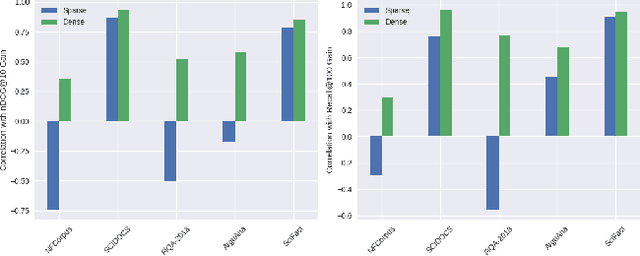
Document expansion (DE) via query generation tackles vocabulary mismatch in sparse retrieval, yet faces limitations: uncontrolled generation producing hallucinated or redundant queries with low diversity; poor generalization from in-domain training (e.g., MS MARCO) to out-of-domain data like BEIR; and noise from concatenation harming dense retrieval. While Large Language Models (LLMs) enable cross-domain query generation, basic prompting lacks control, and taxonomy-based methods rely on domain-specific structures, limiting applicability. To address these challenges, we introduce Doc2Query++, a DE framework that structures query generation by first inferring a document's latent topics via unsupervised topic modeling for cross-domain applicability, then using hybrid keyword selection to create a diverse and relevant keyword set per document. This guides LLM not only to leverage keywords, which ensure comprehensive topic representation, but also to reduce redundancy through diverse, relevant terms. To prevent noise from query appending in dense retrieval, we propose Dual-Index Fusion strategy that isolates text and query signals, boosting performance in dense settings. Extensive experiments show Doc2Query++ significantly outperforms state-of-the-art baselines, achieving substantial gains in MAP, nDCG@10 and Recall@100 across diverse datasets on both sparse and dense retrieval.
What Do Temporal Graph Learning Models Learn?
Oct 10, 2025



Learning on temporal graphs has become a central topic in graph representation learning, with numerous benchmarks indicating the strong performance of state-of-the-art models. However, recent work has raised concerns about the reliability of benchmark results, noting issues with commonly used evaluation protocols and the surprising competitiveness of simple heuristics. This contrast raises the question of which properties of the underlying graphs temporal graph learning models actually use to form their predictions. We address this by systematically evaluating seven models on their ability to capture eight fundamental attributes related to the link structure of temporal graphs. These include structural characteristics such as density, temporal patterns such as recency, and edge formation mechanisms such as homophily. Using both synthetic and real-world datasets, we analyze how well models learn these attributes. Our findings reveal a mixed picture: models capture some attributes well but fail to reproduce others. With this, we expose important limitations. Overall, we believe that our results provide practical insights for the application of temporal graph learning models, and motivate more interpretability-driven evaluations in temporal graph learning research.
Adaptive Decoding via Hierarchical Neural Information Gradients in Mouse Visual Tasks
Oct 10, 2025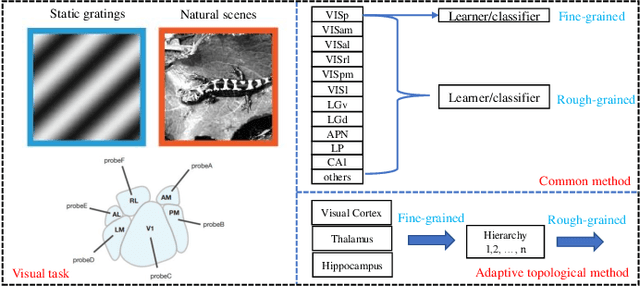
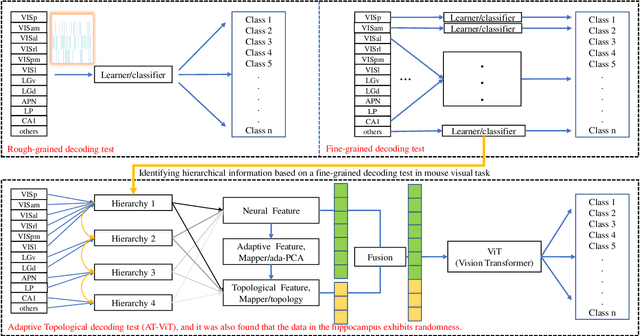
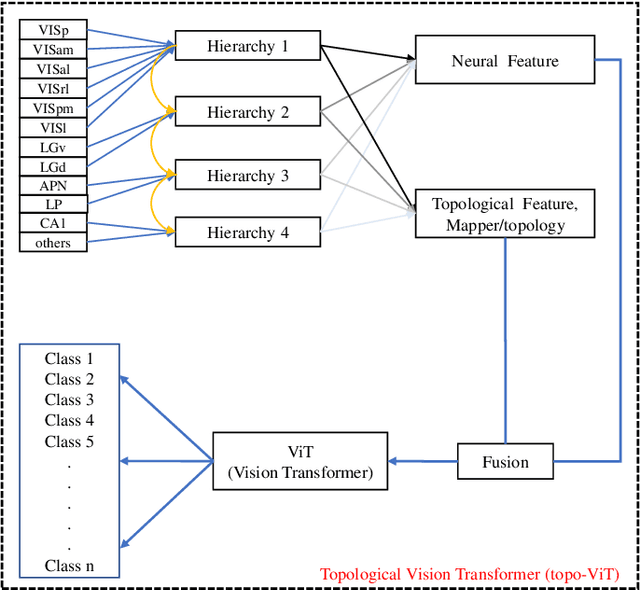
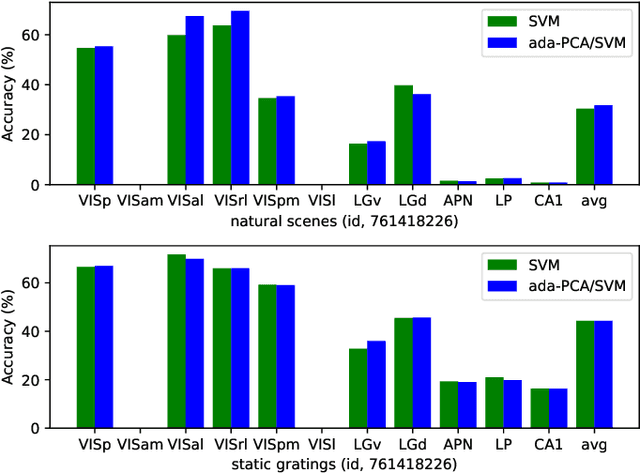
Understanding the encoding and decoding mechanisms of dynamic neural responses to different visual stimuli is an important topic in exploring how the brain represents visual information. Currently, hierarchically deep neural networks (DNNs) have played a significant role as tools for mining the core features of complex data. However, most methods often overlook the dynamic generation process of neural data, such as hierarchical brain's visual data, within the brain's structure. In the decoding of brain's visual data, two main paradigms are 'fine-grained decoding tests' and 'rough-grained decoding tests', which we define as focusing on a single brain region and studying the overall structure across multiple brain regions, respectively. In this paper, we mainly use the Visual Coding Neuropixel dataset from the Allen Brain Institute, and the hierarchical information extracted from some single brain regions (i.e., fine-grained decoding tests) is provided to the proposed method for studying the adaptive topological decoding between brain regions, called the Adaptive Topological Vision Transformer, or AT-ViT. In numerous experiments, the results reveal the importance of the proposed method in hierarchical networks in the visual tasks, and also validate the hypothesis that "the hierarchical information content in brain regions of the visual system can be quantified by decoding outcomes to reflect an information hierarchy." Among them, we found that neural data collected in the hippocampus can have a random decoding performance, and this negative impact on performance still holds significant scientific value.
Vision Language Models: A Survey of 26K Papers
Oct 10, 2025We present a transparent, reproducible measurement of research trends across 26,104 accepted papers from CVPR, ICLR, and NeurIPS spanning 2023-2025. Titles and abstracts are normalized, phrase-protected, and matched against a hand-crafted lexicon to assign up to 35 topical labels and mine fine-grained cues about tasks, architectures, training regimes, objectives, datasets, and co-mentioned modalities. The analysis quantifies three macro shifts: (1) a sharp rise of multimodal vision-language-LLM work, which increasingly reframes classic perception as instruction following and multi-step reasoning; (2) steady expansion of generative methods, with diffusion research consolidating around controllability, distillation, and speed; and (3) resilient 3D and video activity, with composition moving from NeRFs to Gaussian splatting and a growing emphasis on human- and agent-centric understanding. Within VLMs, parameter-efficient adaptation like prompting/adapters/LoRA and lightweight vision-language bridges dominate; training practice shifts from building encoders from scratch to instruction tuning and finetuning strong backbones; contrastive objectives recede relative to cross-entropy/ranking and distillation. Cross-venue comparisons show CVPR has a stronger 3D footprint and ICLR the highest VLM share, while reliability themes such as efficiency or robustness diffuse across areas. We release the lexicon and methodology to enable auditing and extension. Limitations include lexicon recall and abstract-only scope, but the longitudinal signals are consistent across venues and years.
Do LLMs Really Need 10+ Thoughts for "Find the Time 1000 Days Later"? Towards Structural Understanding of LLM Overthinking
Oct 09, 2025Models employing long chain-of-thought (CoT) reasoning have shown superior performance on complex reasoning tasks. Yet, this capability introduces a critical and often overlooked inefficiency -- overthinking -- models often engage in unnecessarily extensive reasoning even for simple queries, incurring significant computations without accuracy improvements. While prior work has explored solutions to mitigate overthinking, a fundamental gap remains in our understanding of its underlying causes. Most existing analyses are limited to superficial, profiling-based observations, failing to delve into LLMs' inner workings. This study introduces a systematic, fine-grained analyzer of LLMs' thought process to bridge the gap, TRACE. We first benchmark the overthinking issue, confirming that long-thinking models are five to twenty times slower on simple tasks with no substantial gains. We then use TRACE to first decompose the thought process into minimally complete sub-thoughts. Next, by inferring discourse relationships among sub-thoughts, we construct granular thought progression graphs and subsequently identify common thinking patterns for topically similar queries. Our analysis reveals two major patterns for open-weight thinking models -- Explorer and Late Landing. This finding provides evidence that over-verification and over-exploration are the primary drivers of overthinking in LLMs. Grounded in thought structures, we propose a utility-based definition of overthinking, which moves beyond length-based metrics. This revised definition offers a more insightful understanding of LLMs' thought progression, as well as practical guidelines for principled overthinking management.
FinMR: A Knowledge-Intensive Multimodal Benchmark for Advanced Financial Reasoning
Oct 09, 2025Multimodal Large Language Models (MLLMs) have made substantial progress in recent years. However, their rigorous evaluation within specialized domains like finance is hindered by the absence of datasets characterized by professional-level knowledge intensity, detailed annotations, and advanced reasoning complexity. To address this critical gap, we introduce FinMR, a high-quality, knowledge-intensive multimodal dataset explicitly designed to evaluate expert-level financial reasoning capabilities at a professional analyst's standard. FinMR comprises over 3,200 meticulously curated and expertly annotated question-answer pairs across 15 diverse financial topics, ensuring broad domain diversity and integrating sophisticated mathematical reasoning, advanced financial knowledge, and nuanced visual interpretation tasks across multiple image types. Through comprehensive benchmarking with leading closed-source and open-source MLLMs, we highlight significant performance disparities between these models and professional financial analysts, uncovering key areas for model advancement, such as precise image analysis, accurate application of complex financial formulas, and deeper contextual financial understanding. By providing richly varied visual content and thorough explanatory annotations, FinMR establishes itself as an essential benchmark tool for assessing and advancing multimodal financial reasoning toward professional analyst-level competence.
ToolLibGen: Scalable Automatic Tool Creation and Aggregation for LLM Reasoning
Oct 09, 2025



Large Language Models (LLMs) equipped with external tools have demonstrated enhanced performance on complex reasoning tasks. The widespread adoption of this tool-augmented reasoning is hindered by the scarcity of domain-specific tools. For instance, in domains such as physics question answering, suitable and specialized tools are often missing. Recent work has explored automating tool creation by extracting reusable functions from Chain-of-Thought (CoT) reasoning traces; however, these approaches face a critical scalability bottleneck. As the number of generated tools grows, storing them in an unstructured collection leads to significant retrieval challenges, including an expanding search space and ambiguity between function-related tools. To address this, we propose a systematic approach to automatically refactor an unstructured collection of tools into a structured tool library. Our system first generates discrete, task-specific tools and clusters them into semantically coherent topics. Within each cluster, we introduce a multi-agent framework to consolidate scattered functionalities: a code agent refactors code to extract shared logic and creates versatile, aggregated tools, while a reviewing agent ensures that these aggregated tools maintain the complete functional capabilities of the original set. This process transforms numerous question-specific tools into a smaller set of powerful, aggregated tools without loss of functionality. Experimental results demonstrate that our approach significantly improves tool retrieval accuracy and overall reasoning performance across multiple reasoning tasks. Furthermore, our method shows enhanced scalability compared with baselines as the number of question-specific increases.
 Add to Chrome
Add to Chrome Add to Firefox
Add to Firefox Add to Edge
Add to Edge